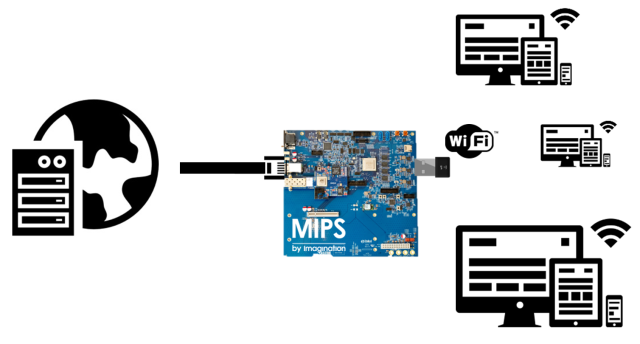
A company that designs MIPS processors for networking hardware says it is developing technology that would allow installation of open source firmware on wireless routers while still complying with the US Federal Communications Commission's latest anti-interference rules.
The FCC now requires router makers to prevent third-party firmware from changing radio frequency parameters in ways that could cause interference with other devices, such as FAA Doppler weather radar systems.
The easiest way for router makers to comply is to simply prevent installation of open source firmware altogether. Linksys came up with its own way of allowing open source firmware, but so far there's no method that scales across the industry, and at least some routers from TP-Link and Asus are being locked down.
But a chip design company called Imagination Technologies has partnered with open source software makers to put third-party firmware such as OpenWrt into a virtual machine that's isolated from radio controls.
Right now it's just a demonstration and isn't ready for deployment, but the company says it's possible that the capabilities could hit the market sometime in 2017. The demo was sponsored by the prpl Foundation, an open source-focused nonprofit that was created by Imagination and other tech companies including Broadcom, Cavium, and Qualcomm.
As a result, third-party firmware like OpenWrt and DD-WRT can be installed in virtual machines that are isolated from the software that controls radio frequency parameters, satisfying the FCC requirements. This could preserve users' ability to replace the firmware that's pre-installed by hardware vendors and customize their routers.
In the demo, OpenWrt is installed in one virtual machine. A "second virtual machine runs the Wi-Fi driver; there is no direct access to the driver from other VMs, except through the virtual network connection," Imagination says.
The virtualization software used in the demo is L4Re, an open source hypervisor that previously ran only on x86 and ARM architectures. L4Re was ported to MIPS for this project, and a new source code release will include MIPS support, L4Re maker Kernkonzept told Ars.
The demo shows that virtual machines can be isolated from each other while they're running; if one VM crashes, the others are unaffected. But it is incomplete: there is more work to be done to make sure the hypervisor and guest operating systems are authenticated and not hacked when they boot up. Imagination officials say it should be done within a year.
There's no guarantee that this technology will come to consumer routers, but company officials say they are confident. Although the demo is focused on compliance with FCC rules, Imagination says this technology will help router makers add features without causing security problems. The demo includes a third virtual machine that "acts as a sandbox for running third party applications that provide additional functionality" such as smart home automation, the announcement says.
Imagination officials say they began working on hardware virtualization about six years ago, and it took a few years to hone the technology's efficiency and performance. The hardware virtualization became available in 2013 with the release of the first MIPS Warrior processors. The performance hit from virtualization is minimal, less than 2 percent in one recent test.
Imagination doesn't make chips itself. Instead, it makes designs and licenses them to semiconductor manufacturers. Chip makers using Imagination designs include Qualcomm Atheros, Realtek, MediaTek, Lantiq (owned by Intel), Ikanos (owned by Qualcomm Atheros), and Baikal Electronics, the company told Ars. Broadcom and Cavium design their own MIPS-based chips instead of purchasing from Imagination.
TP-Link, Belkin, Linksys, Securifi, and BT are among the companies that have made routers using older versions of Imagination-designed chips, the company says. Imagination's announcement urges router makers to adopt the new design—whenever it's ready.
"By adopting chipsets built using the latest MIPS Warrior CPUs, networking manufacturers can ensure the wireless driver complies with the FCC guidelines on security while still satisfying the requirements of the open source community," the company says.
reader comments
88